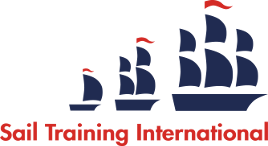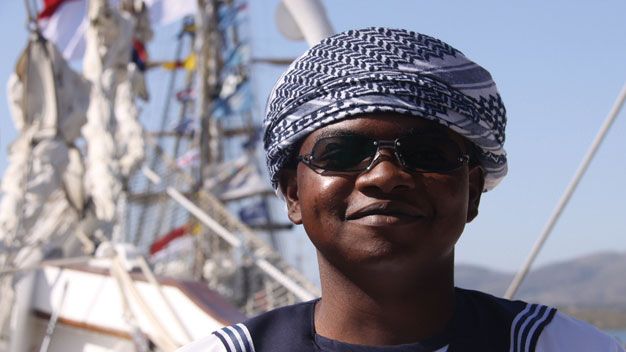Duties of trainees on Shabab Oman
The Royal Navy of Oman’ 44m Barquentine Shabab Oman that arrived in Volos yesterday was built in 1971 and is a regular in The Tall Ships Races and large tall ships gatherings around the world. She is recognised by the red dagger and crossed swords, the national symbol of Oman, on her topsails. In port she is also difficult to miss. This sparkling example of a well maintained naval ship takes pride of place in the port of Volos and this morning is welcoming many visitors onboard.
Shabab Oman’ deployment from Oman started 24 days ago following five months of maintenance. Her journey took her all the way down the Arabian Sea into the Red Sea to Egypt, through the Suez Canal and then on to Volos. According to Lt Cdr Saif Nasser Alrahbi, the ship’ captain, when she returns to Oman she’ll undergo further maintenance. äóìThe reason she looks so good is because of her constant maintenance. The ship is run under the Sultan’ directive so he is very concerned about how well she is looked after.äó
One of the most interesting aspects for the trainees during their time at sea on this Islamic ship is having to carry out their prayers while racing. But according to Lt Azizyahya al-Husaini – logistics officer – it is not a problem. äóìOur Islamic faith means we have to pray when sailing. If you cannot stand up because of bad weather you can sit, if you are sick you can pray lying down in your bed. Whatever happens you have to pray to God.äó
The usual prayers of five times a day is however, reduced to three times when carrying out a journey, and prayers take just five minutes a session. Azizyahya al-Husaini continued: ” gift from God allows us to reduce the prayer time when travelling, he asked us to pray only three times, which means the first prayer has to be in the morning but the second and third pray can be done together as one prayer, the fourth and fifth can also be brought together. We can’t all pray together when sailing so we have to take turns. The second prayer is between noon and sunset, and the last one, from sunset all the way to 0100 in the morning.äó
The strict sail training regime aboard Shabab Oman means young trainees really benefit from their four months at sea. The youngest trainees are 20 year’ old, and from forces other than the Navy, such as the army, air force and police. Captain Cdr Saif Nasser Alrahbi commented: äóìWhen they get on board they don’t go ashore for four months which means they come back stronger men.äó
Twenty-year-old trainee Taysir (pictured above) who’ a musician in the Navy, commenting on the training said: äóìSailing on this ship and being away for four months gives us a real opportunity to learn a lot. I sailed on this ship in 2008 but this time I learned how to work the ship, helm the ship, how to hoist the sails, go aloft and how to drop the sails. I am looking forward to the race and really want to win. We have a good team. Although I’d like to train to be a captain one day, my ambition is limited because of my musical career.äó


